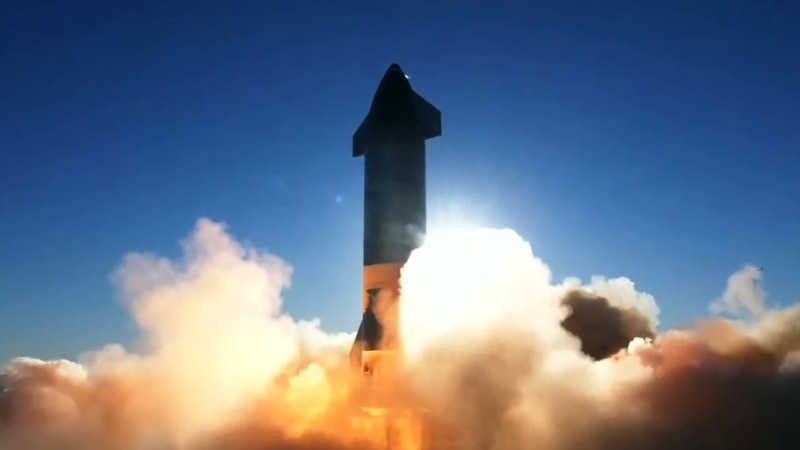
2020 Saw Many Successes in Space Exploration
Space exploration gave moments of hope in a difficult year.
Three countries sent spacecraft toward Mars in 2020. Astronauts launched into orbit from the United States for the first time in nearly 10 years. And robotic explorers collected rocks from the Moon and from an asteroid.
High Expectations for 2021
Expectations are high for 2021 also. Next February, landings are expected on Mars and the planned launch of the James Webb Space Telescope is to take place in the autumn. The huge telescope is taking the place of the famous Hubble Space Telescope.
Other developments are expected too. The aerospace company Boeing hopes to catch up with SpaceX in launching astronauts. And space tourism may finally get off the ground.
Scott Hubbard served as the U.S. space agency’s (NASA) first Mars program director. He now teaches at Stanford University. He said, “2021 promises to be as much of a space exploration bright spot, perhaps even more.”
Big Projects Moved Forward
Although the coronavirus crisis created problems for all space programs in 2020, most very important projects still went forward.
The U.S., China and the United Arab Emirates launched spacecraft toward Mars.
NASA’s Perseverance robot explorer is set to land on February 18. Perseverance will cut into the dry soil, collecting samples for return to Earth.
The UAE’s spacecraft is that country’s first attempt to visit another planet. It will study the Martian atmosphere.
China’s Tianwen-1 will look for signs of ancient life on the red planet.
China also carried out explorations of the Moon in 2020. In December, a Chinese spacecraft landed and then launched off the moon's surface. It collected the first moon rocks returned to Earth since the 1970s.
Japan brought back pieces of the asteroid Ryugu. More asteroid samples are on the way. NASA’s Osiris-Rex spacecraft got samples from the asteroid Bennu in October. The samples are planned to return in 2023.
Elon Musk’s company SpaceX did a lot in 2020. In May, SpaceX became the first private company to send people into orbit, a success that could only be claimed by three powerful nations before.
In November, four more astronauts rode a SpaceX Dragon to the International Space Station. Three weeks later, SpaceX launched its biggest shipment yet to the space station for NASA.
Mark Kelly who was elected as a Senator for the state of Arizona said the event was something “Americans should be proud of.”
Until the SpaceX flights, Russia’s three-person Soyuz spacecraft were the only way to get astronauts to the space station after NASA’s flights stopped.
SpaceX ended the year with a test flight of Starship, the spacecraft the company is building to carry people to the moon and Mars. The event on December 9 was marked by an explosion on landing. Even so, Musk said he was extremely happy.
In addition, SpaceX is expanding the number of people willing to ride in its Dragon spaceship. Late next year, SpaceX expects to launch the first privately financed Dragon flight in a deal with Houston-based Axiom Space.
Axiom’s Michael Lopez-Alegria, an ex-NASA astronaut and former president of the Commercial Spaceflight Federation, will go with Israeli businessman Eytan Stibbe. They will be joined by two other people paying to visit the space station.
“This is the true beginning of private spaceflight and will get the ball rolling toward multiple private missions to orbit per year,” Lopez-Alegria said in an email.
Two other space-travel companies are still doing test flights. They are Jeff Bezos’ Blue Origin and Richard Branson’s Virgin Galactic. Those companies have not yet set dates for sending people on short flights to the edge of space and back.
The Future of Space Programs in the U.S.
U.S. President Donald Trump said he wants a moon landing by American astronauts to happen by 2024. It would be the first since NASA’s Apollo program more than 50 years ago.
In December, NASA introduced 18 astronauts who will train for the moon program named Artemis.
John Logsdon of George Washington University’s Space Policy Institute said the last four years “have been positive for the U.S. civilian space program.” Logsdon added, “No...major programs were cancelled, the human exploration program was given clear direction, and funding for existing programs was increased.”
I’m John Russell.
Marcia Dunn reported this story for the Associated Press. John Russell adapted it for VOA Learning English. Mario Ritter, Jr. was the editor.
Words in This Story
spacecraft – n. a vehicle that is used for travel in outer space
asteroid -- n. any one of thousands of small planets that circle around the sun
tourism – n. the activity of traveling to a place for pleasure
spot -- n. a small area of a surface that is different from other areas: a particular space or area
sample -- n. a small amount of something that gives you information about the thing it was taken from
multiple – adj. more than one
mission -- n. a task or job that someone is given to do
proud – adj. causing people to be pleased
positive – adj. a good result, not bad
funding – n. available money for a purpose
Share this article:
This article uses material from the VOA Learning English article, and is in public domain. Images and videos are available under their respective licenses.

